A Numerical Study On Cavity Expansion In Water: Hydraulic Ram Under Ballistic Impacts
Price
Free (open access)
Transaction
Volume
126
Pages
12
Page Range
203 - 214
Published
2012
Size
1,335 kb
Paper DOI
10.2495/SU120181
Copyright
WIT Press
Author(s)
A. Charles, E. Deletombe & J. Dupas
Abstract
In the field of aircraft safety, solving coupled high speed dynamic fluid-structure problems is sometimes needed, where large deformations or even rupture of the structure have to be considered. The presented work deals with the vulnerability of aircraft fuel tank to high velocity impacts, and more specifically with the prediction of hydraulic ram effects that such impacts can produce on fuel tank structures. In the present work, the authors explored the possibility offered by the EUROPLEXUS code to model the expansion and collapse of cavities that develop in containers after impact and arrest by water of ballistic projectiles. An original experimental test case is used to challenge the EUROPLEXUS code, which a 3 kJ, 850 m/s, 7, 72 mm projectile being fired in various containers, equipped with high speed cameras to capture cavity expansion and collapsing phases. The objective of the present numerical exercise was to evaluate which proportion of the kinetic energy of such a bullet could be converted into internal energy (pressure, heat), fluid kinetic energy and latent energy of the water, to estimate how much of, and how dynamically, this energy could finally be transferred to a deformable fuel tank structure to possibly damage it. Keywords: hydraulic ram, FE simulations, cavity expansion.
Keywords
hydraulic ram, FE simulations, cavity expansion





